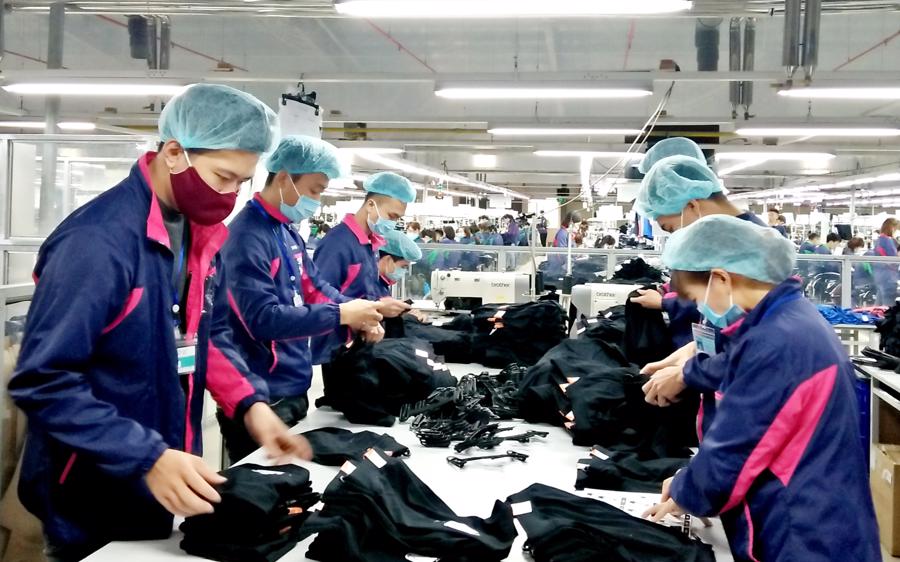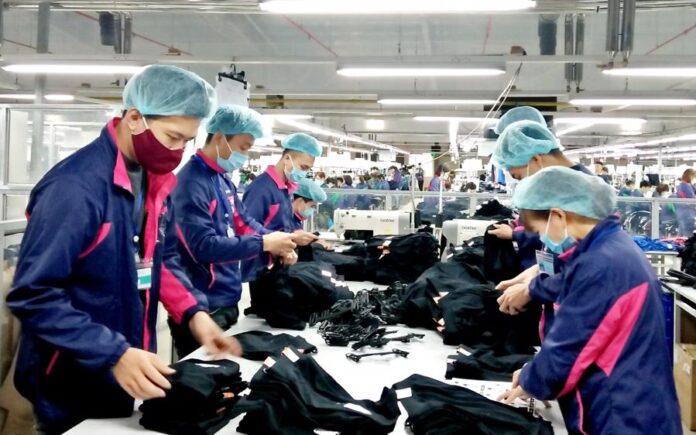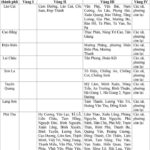From July 1, 2025, the list of communal-level areas that will apply the minimum wage for employees working under labor contracts will be implemented according to the Appendix issued together with Decree No. 128/2025/ND-CP of the Government on the regulation of decentralization in the field of home affairs.
Decree 128 takes effect from July 1, 2025, stipulating that from this date onwards, the determination of the regional minimum wage according to the district-level administrative unit will be shifted to the communal-level administrative unit.
When applying the monthly and hourly minimum wage for employees working for employers in communal-level areas as specified in the Appendix to this Decree, if there are any cases where the minimum wage is lower than before July 1, 2025, the employer shall continue to apply the minimum wage that was applied for the district-level area before July 1, 2025, until the Government issues new regulations.
The current regional minimum wage is stipulated in Decree No. 74/2024/ND-CP of the Government on the minimum wage for employees working under labor contracts, with four wage regions. Accordingly, the minimum wage in Region I is currently VND 4.96 million/month; Region II is VND 4.41 million/month; Region III is VND 3.86 million/month; and Region IV is VND 3.45 million/month.
The corresponding hourly minimum wage in Region I is VND 23,800/hour, Region II is VND 21,200/hour, Region III is VND 18,600/hour, and Region IV is VND 16,600/hour.
The minimum wage is the lowest wage paid to employees performing the simplest work in normal working conditions, ensuring the minimum living standards for employees and their families, in accordance with socio-economic development conditions.
The application of the regional area is determined based on the location of the employer’s operations, as specified in Clause 3, Article 3 of Decree 74/2024/ND-CP.
Specifically, employers operating in areas belonging to a particular region shall apply the minimum wage prescribed for that region.
Employers with units or branches operating in areas with different minimum wages shall apply the minimum wage prescribed for the area where the unit or branch is located.
Employers operating in industrial parks or export processing zones located in areas with different minimum wages shall apply the minimum wage of the area with the highest minimum wage.
In cases where the employer’s location of operation undergoes a change in name or administrative division, the minimum wage prescribed for the area before such changes shall be temporarily applied until the Government issues new regulations.
For employers operating in newly established areas or areas with different minimum wages, the minimum wage of the area with the highest minimum wage shall be applied.

The list of communal-level areas applying the regional minimum wage from July 1, 2025, is as follows:
1. Lao Cai Province
Region II includes Cam Duong, Lao Cai, Coc San, Hop Thanh, and Gia Phu wards, while the remaining wards and communes belong to Region IV.
Region III includes Van Phu, Yen Bai, Nam Cuong, Au Lau, and Sa Pa wards, Phong Hai, Xuan Quang, Bao Thang, Tang Loong, Muong Bo, Ban Ho, Ta Phin, Ta Van, and Ngu Chi Son communes.
2. Cao Bang Province
Region III includes Thuc Phan, Tung Tri Cao, and Tan Giang wards, while the remaining wards and communes belong to Region IV.
3. Dien Bien Province
Region III includes Dien Bien Phu and Muong Thanh wards, and Mường Phăng and Nà Tấu communes, while the remaining wards and communes belong to Region IV.
4. Lai Chau Province
Region III includes Tan Phong and Doan Ket wards, while the remaining wards and communes belong to Region IV.
5. Son La Province
Region III includes To Hieu, Chiềng An, Chiềng Cơi, and Chiềng Sinh wards, while the remaining wards and communes belong to Region IV.
6. Tuyen Quang Province
Region III includes My Lam, Minh Xuan, Nong Tien, An Tuong, Binh Thuan, Ha Giang 1, Ha Giang 2, and Ngoc Duong communes, while the remaining wards and communes belong to Region IV.
7. Lang Son Province
Region III includes Tam Thanh, Luong Van Tri, Hoang Van Thu, and Dong Kinh wards, while the remaining wards and communes belong to Region IV.
8. Phu Tho Province
Region II includes Viet Tri, Nong Trang, Thanh Mieu, Van Phu, Vinh Phuc, Vinh Yen, Phuc Yen, Xuan Hoa, Hoa Binh, Ky Son, Tan Hoa, Thong Nhat, and Hy Cuong communes, while Region III includes Phong Chau, Phu Tho, Au Co, and Lam Thao communes. Region IV includes the remaining wards and communes.
9. Quang Ninh Province
Region IV includes Ba Che, Hoanh Mo, Luc Hon, Binh Lieu, and Co To Special Administrative Unit, while Region II includes Tien Yen, Dien Xa, Dong Ngu, Hai Lang, Quang Tan, Dam Ha, Quang Ha, Duong Hoa, Quang Duc, Cai Chien, and Van Don Special Administrative Unit. Mong Duong, Quang Hanh, Cam Pha, and Cuong Ong wards are in Region II, and the remaining wards and communes are in Region I.
10. Hai Phong City
Region III includes Thanh Ha, Ha Tay, Ha Bac, Ha Dong, Ninh Giang, Vinh Lai, Khuc Thua Du, Tan An, Hong Chau, Thanh Mien, Bac Thanh Mien, Hai Hung, Nam Thanh Mien, and Ha Nam communes, while Region II includes Chu Van An, Chi Linh, Tran Hung Dao, Nguyen Trai, Tran Nhan Tong, Le Dai Hanh, Kinh Mon, Nguyen Dai Nang, Tran Luu, Bac An Phu, Pham Su Manh, Nhi Chieu, and Nam An Phu communes. Region I includes the remaining wards, communes, and special administrative units.
11. Hung Yen Province
Region II includes Pho Hien, Son Nam, Hong Chau, My Hao, Duong Hao, Thuong Hong, Thai Binh, Tran Lam, Tran Hung Dao, Tra Ly, Vu Phuc, Tan Hung, Yen My, Viet Yen, Hoan Long, Nguyen Van Linh, Nhu Quynh, Lac Dao, Dai Dong, Nghia Tru, Phung Cong, Van Giang, and Me So communes, while Region IV includes the remaining wards and communes.
12. Thai Nguyen Province
Region II includes Phan Dinh Phung, Linh Son, Tich Luong, Gia Sang, Quyet Thang, Quan Trieu, Pho Yen, Van Xuan, Trung Thanh, Phuc Thuan, Song Cong, Ba Chuan, and Dai Phuc communes, while Region III includes Duc Xuan, Bac Kan, Dai Tu, Duc Luong, Phu Thinh, La Bang, Phu Lac, An Khanh, Quan Chu, Van Phu, Phu Xuyen, Phu Binh, Tan Thanh, Diem Thuy, Kha Son, Tan Khanh, Dong Hy, Van Han, Van Lang, Phu Luong, Vo Tranh, Yen Trach, Hop Thanh, and Phong Quang communes. The remaining wards and communes belong to Region IV.
13. Bac Ninh Province
Region IV includes Chu, Phuong Son, Dai Son, Son Dong, Tay Yen Tu, Duong Huu, Yen Dinh, An Lac, Van Son, Bien Dong, Luc Ngan, Deo Gia, Son Hai, Tan Son, Bien Son, Sa Ly, Nam Duong, Kien Lao, Luc Son, Truong Son, Cam Ly, Dong Phu, Nghia Phuong, Luc Nam, Bac Lung, Bao Dai, Yen The, Bo Ha, Dong Ky, Xuan Luong, Tam Tien, and Tuan Dao communes, while Region III includes Lang Giang, My Thai, Kep, Tan Dinh, Tien Luc, Tan Yen, Ngoc Thien, Nha Nam, Phuc Hoa, Quang Trung, Hop Thinh, Hiep Hoa, Hoang Van, and Xuan Cam communes. The remaining wards and communes are in Region II.
14. Hanoi City
Region II includes Phuong Duc, Chuyen My, Dai Xuyen, Van Dinh, Ung Thien, Hoa Xa, Ung Hoa, My Duc, Hong Son, Phuc Son, Huong Son, Minh Chau, Quang Oai, Vat Lai, Co Do, Bat Bat, Suoi Hai, Ba Vi, Phuc Tho, Phuc Loc, Hat Mon, and Dan Phuong communes, while Region I includes the remaining wards and communes.
15. Ninh Binh Province
Region II includes Tay Hoa Lu, Hoa Lu, Nam Hoa Lu, Dong Hoa Lu, Nam Dinh, Thien Truong, Dong A, Vi Khe, Thanh Nam, Truong Thi, Hong Quang, and My Loc wards, while Region III includes Tam Diep, Yen Son, Trung Son, Yen Thang, Ha Nam, Phu Ly, Phu Van, Chau Son, Lien Tuyen, Duy Tien, Duy Tan, Dong Van, Duy Ha, Tien Son, Le Ho, Nguyen Uy, Ly Thuong Kiet, Kim Thanh, Tam Chuc, Kim Bang, and Gia Vien communes. Region IV includes the remaining wards and communes.
16. Thanh Hoa Province
Region II includes Hac Thanh, Quang Phu, Dong Quang, Dong Son, Dong Tien, Ham Rong, Nguyet Vien, Sam Son, Nam Sam Son, Bi Son, Quang Trung, Ngoc Son, Tan Dan, Hai Linh, Tinh Gia, Dao Duy Tu, Hai Binh, Truc Lam, Nghi Son, Truong Lam, and Cac Son communes, while Region III includes Ha Trung, Tong Son, Ha Long, Hoat Giang, Linh Toai, Trieu Loc, Dong Thanh, Hau Loc, Hoa Loc, Van Loc, Nga Son, Nga Thang, Ho Vuong, Tan Tien, Nga An, Ba Dinh, Hoang Hoa, Hoang Tien, Hoang Thanh, Hoang Loc, Hoang Phu, Hoang Giang, Luu Ve, Quang Yen, Quang Ngoc, Quang Ninh, Quang Binh, Tien Trang, Quang Chinh, Nong Cong, Thang Loi, Trung Chinh, Truong Van, Thang Binh, Tuong Linh, Cong Chinh, Thieu Hoa, Thieu Quang, Thieu Tien, Thieu Trung, Yen Dinh, Yen Phu, Quy Loc, Yen Ninh, Dinh Tan, Dinh Hoa, Tho Xuan, Tho Long, Xuan Hoa, Sao Vang, Lam Son, Tho Lap, Xuan Tin, Xuan Lap, Vinh Loc, Tay Do, Bien Thuong, Trieu Son, Tho Binh, Tho Ngoc, and Tho Phu communes. Region IV includes the remaining wards and communes.
17. Nghe An Province
Region II includes Truong Vinh, Thanh Vinh, Vinh Hung, Vinh Phu, Vinh Loc, Cua Lo, Hung Nguyen, Hung Nguyen Nam, Lam Thanh, Nghi Loc, Phuc Loc, Dong Loc, Trung Loc, Than Linh, Hai Loc, and Van Kieu communes, while Region III includes Hoang Mai, Tan Mai, Quynh Mai, Thai Hoa, Tay Hieu, Dien Chau, Duc Chau, Quang Chau, Hai Chau, Tan Chau, An Chau, Minh Chau, Hung Chau, Do Luong, Bach Ngoc, Van Hien, Bach Ha, Thuan Trung, Luong Son, Van An, Nam Dan, Dai Hue, Thien Nhan, Kim Lien, Nghia Dan, Nghia Tho, Nghia Lam, Nghia Hung, Nghia Khanh, Nghia Loc, Quynh Luu, Quynh Van, Quynh Anh, Quynh Tam, Quynh Phu, Quynh Son, Quynh Thang, Dong Hieu, Yen Thanh, Quan Thanh, Hop Minh, Van Tu, Van Du, Quang Dong, Giai Lac, Binh Minh, and Dong Thanh communes. Region IV includes the remaining wards and communes.
18. Ha Tinh Province
Region III includes Song Tri, Hai Ninh, Hoanh Son, Vung Ang, Thanh Sen, Tran Phu, Ha Huy Tap, and Thach Lac, Dong Tien, Thach Khe, Cam Binh, and Ky Hoa communes, while Region IV includes the remaining wards and communes.
19. Quang Tri Province
Region II includes Dong Hoi, Dong Thuan, and Dong Son wards, while Region III includes Dong Ha, Nam Dong Ha, Ba Don, Bac Gianh, Nam Gianh, Nam Ba Don, Tan Gianh, Trung Thuan, Quang Trach, Hoa Trach, Phu Trach, Thuong Trach, Phong Nha, Bac Trach, Dong Trach, Hoan Lao, Bo Trach, Nam Trach, Quang Ninh, Ninh Chau, Truong Ninh, Truong Son, Le Thuy, Cam Hong, Sen Ngu, Tan My, Truong Phu, Le Ninh, and Kim Ngan communes. Region IV includes the remaining wards, communes, and special administrative units.
20. Hue City
Region II includes Thuan An, Hoa Chau, My Thuong, Vy Da, Thuan Hoa, An Cuu, Thuy Xuan, Kim Long, Huong An, Phu Xuan, Duong No, while Region IV includes A Luoi 1, A Luoi 2, A Luoi 3, A Luoi 4, and A Luoi 5 communes. Region III includes the remaining wards and communes.
21. Da Nang City
Region II includes Hai Chau, Hoa Cuong, Thanh Khe, An Khe, An Hai, Son Tra, Ngu Hanh Son, Hoa Khanh, Lien Chieu, Cam Le, Hoa Xuan, Tam Ky, Quang Phu, Huong Tra, Ban Thach, Hoi An, Hoi An Dong, and Hoi An Tay wards, and Hoa Vang, Hoa Tien, Ba Na, Tan Hiep, and Hoang Sa Special Administrative Unit, while Region III includes Dien Ban, Dien Ban Dong, An Thang, Dien Ban Bac, Nui Thanh, Tam My, Tam Anh, Duc Phu, Tam Xuan, Tam Hai, Tay Ho, Chien Dan, Phu Ninh, Thang Binh, Thang An, Thang Truong, Thang Dien, Thang Phu, Dong Duong, Que Son Trung, Que Son, Xuan Phu, Nong Son, Que Phuoc, Duy Nghia, Nam Phuoc, Duy Xuyen, Thu Bon, Dien Ban Tay, Go Noi, Dai Loc, Ha Nha, Thuong Duc, Vu Gia, Phu Thuan, and the remaining wards and communes belong to Region IV.
22. Quang Ngai Province
Region III includes Truong Quang Trong, Cam Thanh, Nghia Lo, Kon Tum, Dak Cam, Dak Bla, Tinh Khe, An Phu, Binh Minh, Binh Chuong, Binh Son, Van Tuong, Dong Son, Truong Giang, Ba Gia, Son Tinh, Tho Phong, Ngoc Bay, Ia Chim, Dak Rơ Wa, Dak Pxi, Dak Mar, and Dak Ui communes, while Region IV includes the remaining wards, communes, and special administrative units.
23. Dak Lak Province
Region III includes Buon Ma Thuot, Tan An, Tan Lap, Xuan Dai, Song Cau, Thanh Nhat, Ea Kao, Tuy Hoa, Phu Yen, Binh Kien, Dong Hoa, Hoa Hiep, and Hoa Xuan wards, and Hoa Phu, Xuan Tho, Xuan Canh, Xuan Loc communes, while Region IV includes the remaining wards and communes.
24. Khanh Hoa Province
Region II includes Nha Trang, Bac Nha Trang, Tay Nha Trang, Nam Nha Trang, Bac Cam Ranh, Cam Ranh, Cam Linh, Ba Ngoi, Ninh Hoa, Dong Ninh Hoa, and Hoa Thang wards, and Nam Cam Ranh, Bac Ninh Hoa, Tan Dinh, Nam Ninh Hoa, Tay Ninh Hoa, and Hoa Tri communes, while Region III includes Phan Rang, Dong Hai, Ninh Chu, Bao An, Do Vinh, Dai Lanh, Tu Bong, Van Thang, Van Ninh, Van Hung, Dien Khanh, Dien Lac, Dien Dien, Suoi Hiep, Dien Tho, Dien Lam, Cam Lam, Suoi Dau, Cam Hiep, Cam An, Ninh Phuoc, Phuoc Huu, Phuoc Hau, Phuoc Dinh, Ninh Hai, Xuan Hai, Vinh Hai, Thuan Bac, Cong Hai, and the remaining wards, communes, and special administrative units belong to Region IV.
25. Gia Lai Province
Region III includes Quy Nhon, Quy Nhon Dong, Quy Nhon Tay, Quy Nhon Nam, Quy Nhon Bac, Pleiku, Hoi Phu, Thong Nhat, Dien Hong, and An Phu wards, and Bien Ho and Gao communes, while Region IV includes the remaining wards and communes.
26. Lam Dong Province
Region II includes Xuan Huong – Da Lat, Cam Ly – Da Lat, Lam Vien – Da Lat, Xuan
“Unemployment Benefits: A Proposal for Easier Access”
“It is a common misconception that simply fulfilling the requirements of unemployment insurance contributions will guarantee unemployment benefits in the event of job loss. This is not always the case, and there are, in fact, a multitude of factors that determine one’s eligibility for such benefits.”
The Minimum Wage Debate: A 2025 Perspective
The Department of Labor Relations and Wages conducts labor and wage surveys in enterprises to gather data for adjusting regional minimum wages in 2025. This initiative ensures that wage adjustments are informed by accurate and up-to-date insights, reflecting the realities of businesses and their employees.
The Permanent Civil Servants: 3 Scenarios Where They Keep Their Jobs for Life
The 2019 Civil Servant Law Amendment has removed the provision for “lifetime tenure”, however, there remain three scenarios where one can still enjoy this privilege.





















